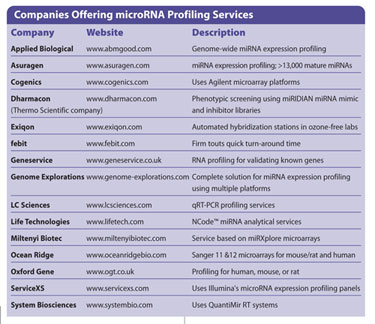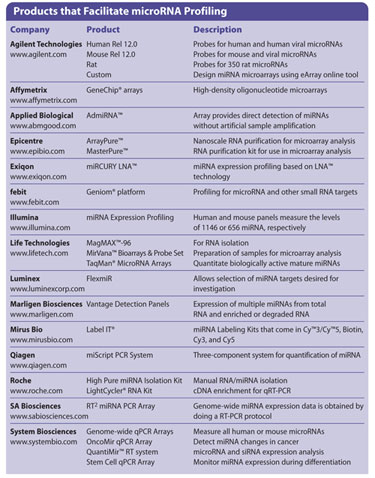March 15, 2009 (Vol. 29, No. 6)
Nina Flanagan
Researchers Are Working to Understand Its Role and the Cellular Pathways It Affects
Many key biological processes are impacted by miRNAs, including cell growth and proliferation, tissue differentiation, embryonic development, and apoptosis. Mutation, dysfunction, and/or dysregulation of miRNA may lead to diseases like coronary artery disease, cancer, diabetes, AIDS, hepatitis, and obesity, to name a few.
Many companies are excited about the potential of miRNAs and are developing novel methods to profile these small RNA molecules and understand which cellular pathways they affect. Later this month, the researchers profiled in this article will be presenting their latest findings at CHI’s “microRNA in Human Disease and Development,” to be held in Boston.
Recent statistics from the National Center for Health Statistics estimate that 34% of U.S. adults are obese. Understanding the role of miRNAs in adipose biology may lead to novel RNA-based therapies for obesity.
Harvey Lodish, Ph.D., professor of biology and bioengineering at MIT, along with graduate student HuangMing Xie, has been profiling and validating the expression of more than 370 miRNAs during adipogenesis of various fat cells. “I’ve been studying fat cells for the past 25 years in various contexts,” states Dr. Lodish. “The hope for this project was that we could find microRNAs that were induced during adipose development that could play some important roles in the biology of cells.”
A number of miRNAs have been discovered that are induced during fat development: two miRNAs upregulated actually sped up the rate at which fat cells are formed by a day, which is substantial. The researchers also compared fat tissue from obese animals versus normal animals.
“What we found very striking is that the same miRNAs that were normally turned on during fat cell differentiation were at a lower level than fat cells from obese animals versus the normal animals.” He concludes that these miRNAs are playing key roles in regulating fat-cell formation. “We’re getting lineage-specific miRNAs that affect the differentiation pathway, making this the first time it’s been done in fat cells.”

Microfluidic Chip Advances Research
A flexible microfluidic array platform, designed with an advanced biochip, is enabling miRNA research, according to LC Sciences. The firm’s µParaflo® chip allows for miRBase synchronicity and design of custom biochips. Although the chip was developed about eight years ago, the company focused on the miRNA market in 2005. The microfluidic technology produces a uniform distribution of the sample solutions on the array and enhances binding reactions and stringency wash processes, says Christoph Eicken, Ph.D., head of technical services, microarrays.
An advanced manufacturing process ensures uniform spots and high reproducibility across lots of arrays and also permits total customization of contents on each individual array. “We have special chemistry where we use regular building blocks to synthesize Tm-optimized probes —meaning we don’t have to use modified oligos or modified amino acids for protein arrays,” explains Dr. Eicken.
“The synthesis that we developed enabled us to use standard oligo-building blocks. We space chemically modified oligos along each of the probes in order to modify those Tm. We feel that’s really important in order to achieve uniform binding,” states Chris Hebel, director of business development. He adds that most of their customers are not microarray experts, and they usually have a few samples of disease versus normal state and want to know if the microRNA is up- or downregulated. “For them, it’s easy to send off the samples and we send them the data. There’s a time savings—it takes about three months after buying a chip to figure out the protocol and to get it to work.”
The company also provides coverage of the latest miRNA sequence information from the Sanger miRBase sequence database.
Future applications include complementary use with sequencing technologies. “Our technology is suited for capturing a portion of a sample, DNA, or RNA, and sequencing a targeting region of that sample. One way is the fact we can synthesize custom arrays with probes designed to capture whatever region of genome or scriptome is being analyzed.
“The other way is that we can use the chip to synthesize probes, which can be cleaved off the array and used for in-solution capture. This is unique as well,” explains Hebel.

miRNA Replacement Therapy
Another increasingly important research focus is on the regulatory role of miRNAs in gene expression and cell growth, differentiation, and death—all of which frequently go awry in cancer. “It might be an advantage that miRNAs affect many cellular pathways, because cancer involves several mutations. You have to look at cancer as a pathway disease,” states Andreas Bader, Ph.D., senior scientist at miRNA Therapeutics. He adds that one of the parameters of how they choose lead candidates is to show how the miRNA affects multioncogenic pathways and shuts them down. “Hopefully, this is why they may be more efficacious than standard targeted therapies.”
This, says Matt Winkler, Ph.D., CEO, is a key point. “We’re looking at tumors that have lost or express low levels of a particular miRNA, and we’re replacing that missing and naturally occurring miRNA—triggering apoptosis, tumor regression, etc. So, we like to call it miRNA replacement therapy.” He adds that it’s “akin to providing insulin to a diabetic.”
The company has chosen to focus on three cancers: non-small-cell lung cancer, metastatic prostate cancer, and acute myelogenous leukemia. Six recently discovered miRNAs show the ability to induce a response in lung and prostate cancers in animal models—meaning interference with the oncogenic property of tumor cells, i.e., inhibition of tumor growth or regression of tumor growth by inducing cell death.
Another advantage to the miRNA therapeutic approach is that it’s similar to gene therapy, but doesn’t have to be delivered into the cell nucleus to be active—only the cytoplasm. Also, since what’s being replaced is a natural molecule this avoids problems associated with antisense and siRNA approaches, such as unwanted side effects and nonspecificity.
Tapping into Stem Cells
Researchers at Life Technologies began to explore the expression profiles of embryonic stem cells a few years ago and discovered distinct miRNAs highly expressed in these cells. This subset of miRNAs associated with pluripotent cells is thought to be important for maintenance of stem cells in their undifferentiated state. This work was enabled by internally developed miRNA profiling tools.
“One of the challenges was using these tools for mesenchymal stem cells because they are not as homogeneous as embryonic stem cells. We had to adapt an alternate approach to identify potential gene targets of the identified miRNAs and validate their role in a particular pathway. So it was a bit more complicated,” explains Uma Lakshmipathy, Ph.D., principal scientist.
The next challenge is to identify specific gene targets of these miRNAs and the effect of miRNA-target interaction on transcriptional networks and signaling pathways. “This information will be critical in identifying the precise role of miRNAs in a particular cellular process,” adds Dr. Lakshmipathy. She adds that another key challenge is to validate all the cell-type specific miRNAs identified so far.
In order to address these challenges, the company has developed miRNA array platforms for analysis of known miRNAs in cells (NCode miRNA multispecies/human array), the IVGN NCode miRNA Microarray kit v3 with novel human miRNA and all known miRNAs in the Sanger miRBase Sequencing Database, a multispecies miRNA kit (v2), and ABI TaqMan Human MicroRNA array.
In addition, there are also reagents for the SOLiD sequencing platform, designed for whole genome analysis and discovery of small noncoding RNA and miRNAs. Potential applications include diagnostics for identification of biomarkers associated with disease, characterization tools to qualify stem cell populations used as therapeutics, as well as embryotoxicity assays to be used in the drug discovery process. “The ultimate goal is to use miRNAs to modulate gene expression to obtain desired cell effects,” summarizes Dr. Lakshmipathy.
Most pancreatic cancers are diagnosed late because they remain asymptomatic until the end stages of disease. Scientists at Asuragen have developed a miRNA-based qRT-PCR assay that differentiates pancreatic ductal adenocarcinoma (PDAC) from chronic pancreatitis. “There can be masses associated with pancreatitis that are benign, so you don’t want to put the patient through surgery if you don’t have to,” says Anna Schwarzbach, Ph.D., CLIA lab supervisor.
Two differentially expressed miRNAs—miR-196a and miR-217—have shown the ability to distinguish PDAC from chronic pancreatitis. The assay using this miRNA signature was validated using FFPE pancreatic blocks and achieved close to 95% specificity and sensitivity, Dr. Schwarzbach said.
Some preliminary data with fine needle aspirates of PDAC and normal pancreatic tissue demonstrated these two miRNAs could identify PDAC patients. Dr. Schwarzbach says they are now in the process of establishing collaborations to obtain larger numbers of fine-needle aspirates for a larger, multicenter study. This will allow for true assessment of the assay’s clinical and analytical parameters in fine-needle aspirate tissues.
Some advantages to working with miRNAs include the fact that they may potentially have more potent changes in expression upon disease development than mRNAs because there are single miRNAs that can regulate multiple mRNAs. Also, since they are smaller than mRNAs, they are less prone to degradation and are easily recovered from FFPE samples.

µParaflo® chips are particularly suited for applications where small sample consumption, freedom from contamination, and performance-reproducibility are primary concerns, according to LC Sciences.
miRNAs in Lupus
Researchers at the University of Pennsylvania School of Medicine are investigating the role of miRNAs in the pathogenesis of systemic lupus erythematosus (SLE). “We are currently profiling miRNAs in T and B cells deriving from the lupus-prone tri-congenic mouse model, B6.Sle123,” says Marianthi Kiriakidou, M.D., associate professor.
The miRNA from these mice is compared to that of a control mouse strain. Since the disease in SLE mice evolves as they age, Dr. Kiriakidou says they also study and compare the miRNA signature among younger and older SLE mice. So far, several miRNAs have been identified that are regulated in SLE mice.
Lupus is a systemic autoimmune disease that can potentially affect every organ. “At the molecular level, our understanding of the mechanisms affected in SLE is limited. Changes in the expression of miRNAs, a defected link in the molecular chain that each of these pathways represents, will serve as a marker to trace these pathways, offering new insights into the pathogenesis of lupus.”
In order to further understand what’s occurring on the molecular level, Dr. Kiriakidou says her lab is also focusing on the biology of the miRNAs and proteins of the Argonaute family that associate with miRNAs in forming microRNPs—the functional units in the miRNA pathway. “Proteins that form the microRNPs are the effectors of the microRNA-mediated gene silencing,” she explains. Ongoing studies include in vitro studies using recombinant mouse Ago2, with the goal to characterize the RNA binding and catalytic and translational repressive activity of mammalian Ago2. “Our goal is to probe the function and contribution of miRNAs in an autoimmune disease model,” Dr. Kiriakidou summarizes.
Scientists in the miRNA field believe these molecules hold great promise, as more studies confirm miRNA profiling holds potential to distinguish cancer from normal tissues. Once thought as useless noncoding RNAs, miRNAs are advancing to perhaps revolutionize disease therapeutics and diagnostics. These may well turn out to be the next magic bullet in medicine’s arsenal.







